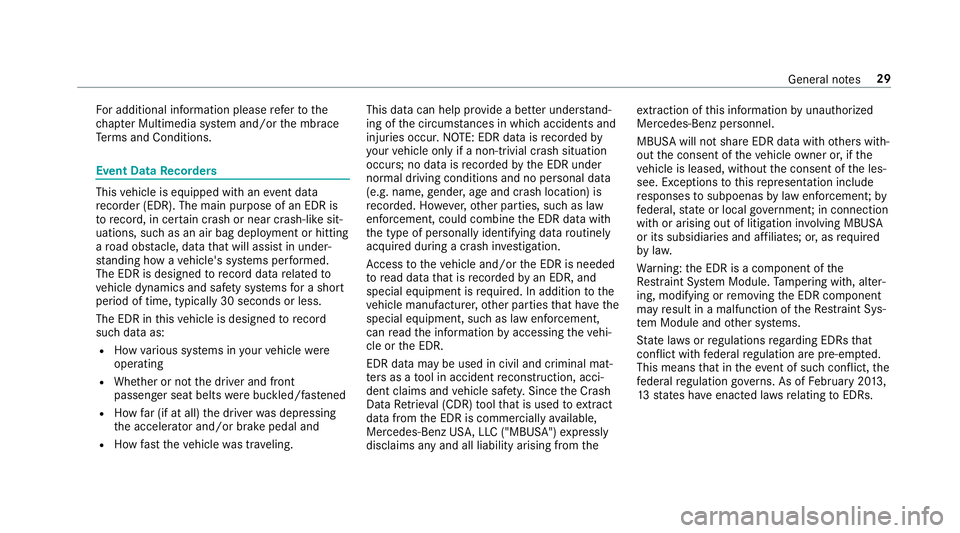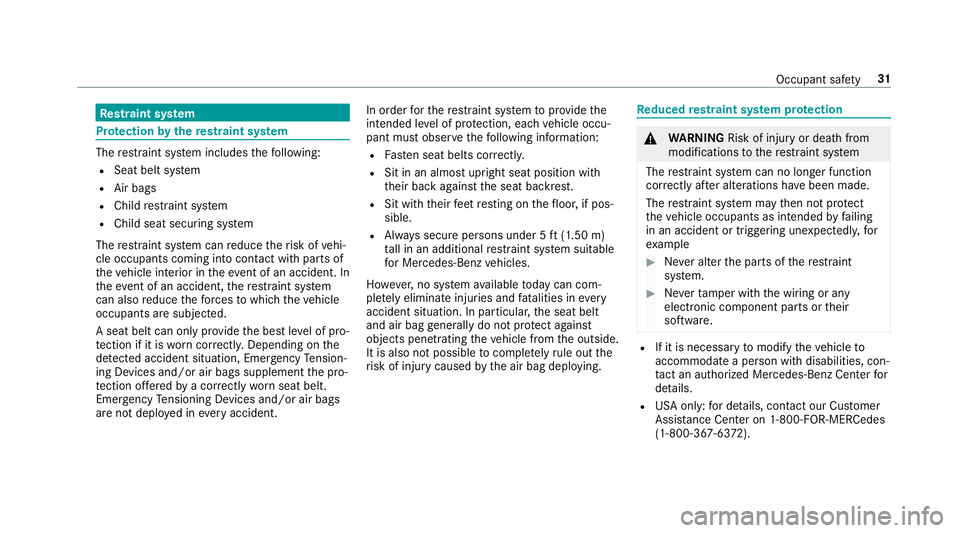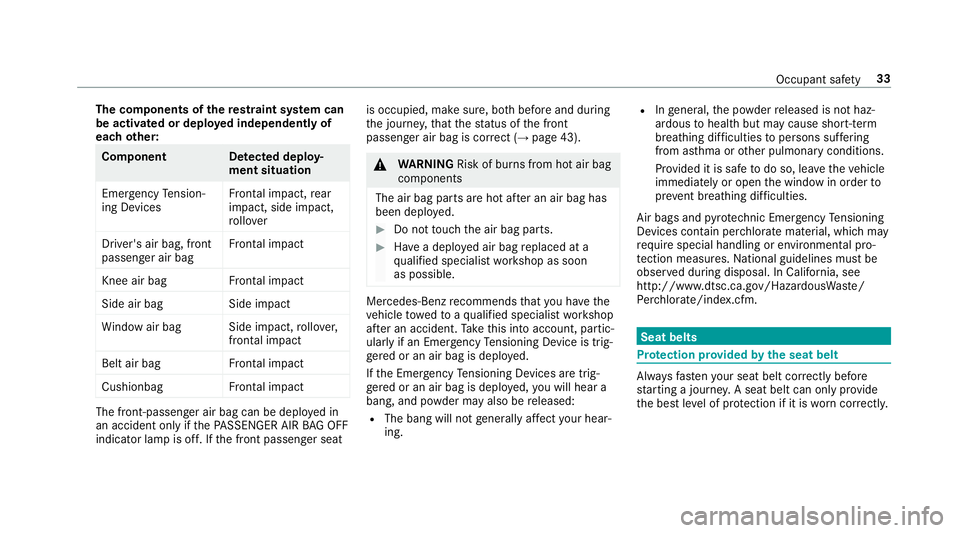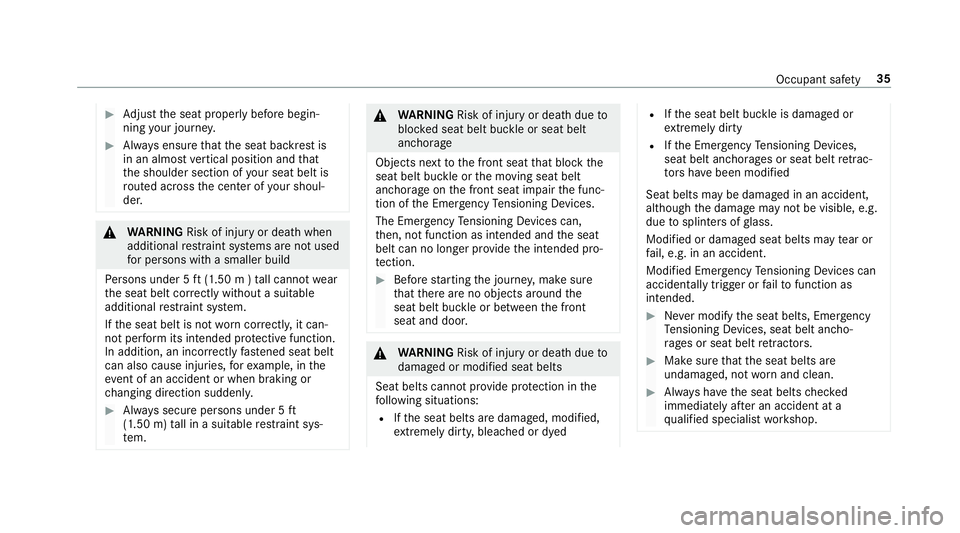2018 MERCEDES-BENZ S-CLASS SEDAN belt
[x] Cancel search: beltPage 4 of 562

Atagl ance .................................................... 6
Cockpit ........................................................... 6
Wa rning and indicator lamps .......................... 8
Overhead control panel ................................ 10
Door control panel and seat adjustment ....... 12
Control settings inthere ar passenger
compartment ................................................ 14
Emergencies and breakdowns ...................... 16
DigitalOperator' sManua l........................ .18
Callin g upthe Digital Operator's Manual ...... 18
General notes............................................. 19
Pr otecting the environment .......................... 19
Mercedes-Benz GenuineParts ....................... 19
Operator's Manual ........................................2 0
Service and vehicle operation ....................... 21
Operating saf ety.......................................... .22
Declaration of conformity for wireless
ve hicle components .....................................2 3
Diagnost ics connection ................................ 24
Qualified specialist workshop ....................... 25
Cor rect use of theve hicle ............................2 5
Problems with your vehicle ........................... 25 Re
porting saf etydefects .............................. .25
Limited Warranty .......................................... 26
QR codes forth ere scue card ....................... 26
Ve hicle data storage .....................................2 6
Copyright .. .................................................... 30
Occupant safety......................................... 31
Re stra int sy stem .......................................... .31
Seat belts ..................................................... 33
Airbags ......................................................... 38
PRE-SAFE
®sy stem ....................................... 45
Children in theve hicle ..................................4 7
No tes on pets in theve hicle .........................5 6
Opening and closing.................................. 58
SmartK ey...................................................... 58
Doors ............................................................ 62
Tr unk ............................................................ 66
Ro ller sun blinds .......................................... .72
Side windo ws................................................ 73
Sliding sunroof ............................................. 77
Anti-theft pr otection .................................... .86
Seats and stowing .................................... .88
No tes on the cor rect driver's seat position ... 88
Seats ............................................................ 89
St eering wheel ............................................ 110
Using the memory function ........................ .113
Memory function in there ar passenger
compartment .............................................. 114
St ow age areas ............................................ .118
Cup holder .................................................. 129
Ashtr ayand cigar ette lighter ...................... .132
Soc kets ....................................................... 134
Re frigerator box .......................................... 137
Wi reless charging of the mobile phone
and connection with theex terior antenna .. 139
Ins talling or removing thefloor mats ........... 141
Ins talling/ removing the pennant holder ...... 141
Light and visibility ................................... 143
Exterior lighting .......................................... 143
Interior lighting ........................................... 148
Wi ndshield wiper and windshield washer
sy stem ........................................................ 149
Mir rors ........................................................ 152
Operating the sun visors ............................. 155
2
Conte nts
Page 11 of 562

1Speedom eter →
244
2 AIR BODY CONTROL malfunctioning →
511
3 #! Turn signal light →
144
4 Multifunction display →
247
5 Tach ome ter →
244
6 å ESP
®OFF →
503
÷ ESP
®→
503
7 K High beam →
144
L Low beam →
143
T Parking lights →
143
8 ? Coolant too hot/cold →
513
9 Coolant temp erature gauge →
244
A · Distance warning →
511
B Ð Steering assis tance malfunction →
512
C # Electrical malfunction →
513
D Brakes (red) →
503
$USA only
J Canada only
E ü Seat belt is not fastened →
510
F Fuel le vel indicator
G 8 Fuelreser vewith fuel filler flap location
indicator →
513
H R Rear fog light →
144
I 6 Restra int sy stem
J % Indicator lamp has no function
K ; Check Engine →
513
L J Brakes (yell ow) →
503
M Electric parking brake applied (red) →
503
F USA only
! Canada only
N h Tire pressure monitoring sy stem →
517
O ! ABS malfunction →
503
P ! Electric pa rking brake (yellow) →
503
Ataglance – Warning and indicator lamps 9
Page 29 of 562

Rstatus messages concerning theve hicle and
its individual components (e.g. number of
wheel revo lutions/speed, decele ration, lat‐
eral acceleration, display of thefast ened seat
belts)
Rmalfunctions or defects in impor tant sy stem
components (e.g. lights, brakes)
Rinformation on vehicle damage events
Rsystem reactions in special driving situations
(e.g. air bag deployment, inter vention of sta‐
bility control sy stems)
Rambient conditions (e.g. temp erature, rain
sensor)
In addition toprov iding the actual control unit
function, this data assists the manufacturer in
de tecting and rectifying malfunctions and opti‐
mizing vehicle functions. The majority of this
data is temp orary and is only processed in the
ve hicle itself. Only a small portion of the data is
st ored in theev ent or malfunction memor y.
When your vehicle is serviced, tech nical da ta
from theve hicle can be read out byservice net‐
wo rkemplo yees or third parties. Services
include repair services, maintenance processes, wa
rranty events and quality assurance meas‐
ures, forex ample. The read out is per form ed via
th e legally prescribed port for OBD ("on-board
diagnostics") in theve hicle. The respective
service network locations or third parties col‐
lect, process and use the data. They document
te ch nical statuses of theve hicle, assist in
find
‐
ing malfunctions and impr oving quality and are
transmitte dto the manufacturer, if necessar y.
Fu rthermore, the manufacturer is subject to
product liability. Forth is, the manufacturer
re qu ires tech nical da tafrom vehicles.
Malfunction memories in theve hicle can be
re set bya service outlet as part of repair or
maintenance work.
They can enter data into theve hicle's con veni‐
ence and inf otainment functions themselves as
part of the selected equipment.
This includes, forex ample:
Rmultimedia data such as music, films or pho‐
to sfo r playba ckin an integrated multimedia
sy stem
Raddress book data for use in connection with
an integrated hands-free sy stem or an inte‐
grated navigation sy stem
Rentered navigation destinations
Rdata about the use of Internet services
This data can be stored locally in theve hicle or
is located on a device which you ha veconnected
to theve hicle. If this data is stored in theve hi‐
cle, you can dele teit at any time. This data can
only be transmitte dto third parties upon your
re qu est with particular rega rd tothe scope of
use of online services according to your selected
settings.
Yo u can store or change con venience settings/
individualization in theve hicle at any time.
Depending on the eq uipment,
this in
cludes,for
ex ample:
Rseat and steering wheel position settings
Rsuspension and climate control settings
Rindividualization such as interior lighting
If yo ur vehicle is accordingly equipped, you can
connect your smartphone or ano ther mobile end
General no tes 27
Page 31 of 562

For additional information please referto the
ch ap ter Multimedia sy stem and/or the mbrace
Te rm s and Conditions.
Event Data Recorders
This vehicle is equipped with an event data
re corder (EDR). The main purp ose of an EDR is
to record, in cer tain crash or near crash-like sit‐
uations, such as an air bag deployment or hitting
a ro ad obs tacle, data that will assist in under‐
st anding how a vehicle's sy stems per form ed.
The EDR is designed torecord data related to
ve hicle dynamics and saf etysy stems for a short
period of time, typically 30 seconds or less.
The EDR in this vehicle is designed torecord
such data as:
RHowvarious sy stems in your vehicle were
operating
RWhe ther or not the driver and front
passenger seat belts werebuckled/fas tened
RHow far (if at all) the driver was depressing
th e accelera tor and/or brake pedal and
RHow fasttheve hicle was tr aveling. This data can help pr
ovide a better under stand‐
ing of the circums tances in which accidents and
inju ries occur. NOTE: EDR data is recorded by
yo ur vehicle only if a non-trivial crash situation
occurs; no data is recorded bythe EDR under
normal driving conditions and no personal data
(e.g. name, gende r,age and crash location) is
re corded. Ho wever,ot her parties, such as law
enforcement, could combine the EDR data with
th e type of personally identifying data routinely
acquired during a crash inve stigation.
Ac cess tothe
ve hicle and/or the E
DR is needed
to read data that is recorded byan EDR, and
special equipment is required. In addition tothe
ve hicle manufacturer, other parties that ha vethe
special equipment, such as law enforcement,
can read the information byaccessing theve hi‐
cle or the EDR.
EDR data may be used in civil and criminal mat‐
te rs as a tool in accident reconstruction, acci‐
dent claims and vehicle saf ety. Since the Crash
Data Retrie val (CDR) tool that is used toextract
da ta from the EDR is commercially available,
Mercedes-Benz US A,LLC ("MBUSA") expressly
disclaims any and all liability arising from the ex
traction of this information byunauthorized
Mercedes-Benz personnel.
MBUSA will not share EDR data withot hers with‐
out the consent of theve hicle owner or, if the
ve hicle is leased, without the consent of the les‐
see. Exceptions tothis representation include
re sponses tosubpoenas bylaw enforcement; by
fe deral, state or local go vernment; in connection
with or arising out of litigation in volvin g MBUSA
or its subsidiari es and affiliates; or, as requ ired
by law.
Wa rning: the EDR is a component of the
Re stra int Sy stem Module. Tamp ering with, alter‐
ing, modifying or removing the EDR component
may result in a malfunction of theRe
stra in
t Sys‐
te m Module and other sy stems.
St ate la wsorregulations rega rding EDRs that
con flict with federal regulation are pre-em pted.
This means that in theeve nt of such conflict,the
fe deral regulation go verns. As of February 20 13,
13 states ha veenacted la wsrelating toEDRs.
General no tes 29
Page 33 of 562

Restra int sy stem
Pr otection bythere stra int sy stem
The restra int sy stem includes thefo llowing:
RSeat belt sy stem
RAir bags
RChild restra int sy stem
RChild seat securing sy stem
The restra int sy stem can reduce therisk of vehi‐
cle occupants coming into contact with parts of
th eve hicle interior in theeve nt of an accident. In
th eev ent of an accident, there stra int sy stem
can also reduce thefo rc es towhich theve hicle
occupants are subjected.
A seat belt can only pr ovide the best le vel of pro‐
te ction if it is worncor rectl y.Depending on the
de tected accident situation, Emergency Tension‐
ing Devices and/or air bags supplement the pro‐
te ction of fere dby a cor rectly wornseat belt.
Emer gency Tensioning Devices and/or air bags
are not depl oyed in everyaccident. In order
forth ere stra int sy stem toprov ide the
intended le vel of pr otection, each vehicle occu‐
pant must obser vethefo llowing information:
RFa sten seat belts cor rectl y.
RSit in an almost up right seat position with
th eir back against the seat backrest.
RSit with their feet resting on thefloor, if pos‐
sible.
RAlw ays secure persons under 5 ft(1.50 m)
ta ll in an additional restra int sy stem suitable
fo r Mercedes-Benz vehicles.
Ho wever,no sy stem available today can com‐
ple tely elimin
ate in
juries and fata lities in every
accident situation. In particular, the seat belt
and air bag generally do not pr otect against
objects penetrating theve hicle from the outside.
It is also not possible tocomplet elyrule out the
ri sk of injury caused bythe air bag deploying.
Re duced restra int sy stem pr otection
&
WARNING Risk of injury or death from
modifications tothere stra int sy stem
The restra int sy stem can no longer function
cor rectly af ter alterations ha vebeen made.
The restra int sy stem may then not pr otect
th eve hicle occupants as intended byfailing
in an accident or triggering unexpec tedly, for
ex ample
#Ne ver alter the parts of there stra int
sy stem.
#Ne verta mp er with the wiring or any
electronic component parts or their
software.
RIf it is necessary tomodify theve hicle to
accommodate a person with disabilities, con‐
ta ct an au thorized Mercedes-Benz Center for
de tails.
RUSA only: for de tails, con tact our Cu stomer
Assis tance Center on 1-800-FOR-MERCedes
(1‑800‑367‑63 72).
Occupant saf ety 31
Page 35 of 562

The components of there stra int sy stem can
be activated or deplo yed independently of
each other:
Component De tected deploy‐
ment situation
Emer gency Tension‐
ing Devices Fr
ontal impact, rear
impact, side impact,
ro llo ver
Driver's air bag, front
passenger air bag Fr
ontal impact
Knee air bag Frontal impact
Side air bag Side impact
Wi ndow air ba gS ide impact,rollo ver,
frontal impact
Belt air bag Frontal impact
Cushionbag Frontal impact
The front-passenger air bag can be deplo yed in
an accident only if thePA SSENGER AIR BAG OFF
indicator lamp is off. If the front passenger seat is occupied, make sure, bo
thbefore and during
th e journe y,that thest atus of the front
passenger air bag is cor rect (
→page 43).
&
WARNING Risk of burn s from hot air bag
components
The air bag parts are hot af ter an air bag has
been deploy ed.
#Do nottouch the air bag parts.
#Ha ve a deplo yed air bag replaced at a
qu alified specialist workshop as soon
as possible.
Mercedes-Benz recommends that you ha vethe
ve hicle towe dto aqu alified specialist workshop
af te r an accident. Take this into account, partic‐
ularly if an Emer gency Tensioning Device is trig‐
ge red or an air bag is deplo yed.
If th e Emer gency Tensioning Devices are trig‐
ge red or an air bag is deplo yed, youwill hear a
bang, and po wdermay also be released:
RThe bang will not generally af fect your hear‐
ing.
RIn general, the powder released is not haz‐
ardous tohealth but may cause short-term
breathing dif ficulties topersons suf fering
from as thma or other pulmonary conditions.
Pr ov ided it is safe todo so, lea vetheve hicle
immediately or open the window in order to
pr eve nt brea thing dif ficulties.
Air bags and pyrotech nic Emergency Tensioning
Devices contain pe rchlorate material, which may
re qu ire special handling or environmental pro‐
te ction measure s.Na tional guidelines must be
obser ved during disposal. In California, see
http://www.dtsc.ca.gov/HazardousWas te/
Pe rchlorate/index.cfm.
Seat belts
Pr otection pr ovided bythe seat belt
Alw aysfast enyour seat belt co rrectly before
st arting a journe y.A seat belt can only pr ovide
th e best le vel of pr otection if it is worncor rectl y.
Occupant saf ety 33
Page 36 of 562

&WARNING Risk of injury or death dueto
incor rectly fastened seat belt
If th e seat belt is not worncor rectly, it can‐
not per form its intended pr otective function.
In addition, an incor rectly fastened seat belt
can also cause injuries, forex ample, in the
ev ent of an accident or when braking or
ch anging direction suddenly .
#Always ensure that all vehicle occu‐
pants ha vetheir seat belts fastened
cor rectly and are sitting prope rly.
In order forth e cor rectly wornseat belt topro‐
vide the intended le vel of pr otection, each vehi‐
cle occupant must obser vethefo llowing infor‐
mation:
RThe seat belt must not be twis ted and must
fi t tightly and snugl yacross the body.
RThe seat belt must be routed across the cen‐
te r of the shoulder and as low down across
th e hips as possible.
RThe shoulder section of the seat belt should
not touch your ne cknor be routed under
yo ur arm or behind your bac k.
RAvoid wearing bulky clo thing, e.g. a winter
coat.
RPush the lap belt down as far as possible
across your hips and pull tight with the shoul‐
der section of the belt. Ne verro ute the lap
belt across your abdomen.
RNe verro ute the seat belt across sharp, poin‐
te d, abrasive or fragile objects.
ROnly one person should use each seat belt at
any one time. Ne ver all owbabies and chil‐
dren totrave l sitting on the lap of ano ther
ve hicle occupant.
RNe ver secure objects with a seat belt if the
seat belt is also being used byone of the
ve hicle's occupants. Alw ays obser vethe
instructions for loading theve hicle when
securing objects, luggage or loads
(
→page 118).
Also ensu rethat no objects are placed
between a person and the seat. e.g. a cush‐
ion. The seat belts on
thefo llowing seats are equip‐
ped with a special seat
beltretractor:
RFront passenger seat
RRe ar seats
Ac tivate or deacti vate the special seatbelt
re tractor of the seat belt (
→page 50).
If ch ildren are tr aveling in theve hicle, be sure to
obser vethe instructions and saf etyno tes on
"Children in theve hicle" (
→page 47).
Re duced seat belt pr otection
&
WARNING Risk of injury or death dueto
incor rect seat position
The seat belt does not of ferth e intended
le ve l of pr otection if you ha venot mo vedth e
seat backrest toan almost vertical position.
When braking or in theev ent of an accident,
yo u could slide underneath the seat belt and
sus tain abdominal or neck injuries, forex am‐
ple.
34 Occupant saf ety
Page 37 of 562

#Adjust the seat proper lybefore begin‐
ning your journe y.
#Always ensure that the seat backrest is
in an almost vertical position and that
th e shoulder section of your seat belt is
ro uted across the center of your shoul‐
der.
& WARNING Risk of injury or death when
additional restra int sy stems are not used
fo r persons with a smaller build
Pe rsons under 5 ft(1.50 m ) tall cannot wear
th e seat belt cor rectly wi thout a suitable
additional restra int sy stem.
If th e seat belt is not worncor rectly, it can‐
not per form its intended pr otective function.
In addition, an incor rectly fastened seat belt
can also cause injuries, forex ample, in the
ev ent of an accident or when braking or
ch anging direction suddenly .
#Always secure persons under 5 ft
(1.50 m) tall in a suitable restra int sys‐
te m.
&
WARNING Risk of injury or death dueto
bloc ked seat belt buckle or seat belt
anchorage
Objects next tothe front seat that block the
seat belt buckle or the moving seat belt
anchorage on the front seat impair the func‐
tion of the Emer gency Tensioning Devices.
The Emergency Tensioning Devices can,
th en, not function as intended and the seat
belt can no longer pr ovide the intended pro‐
te ction.
#Before starting the journe y,make sure
th at there are no objects around the
seat belt buckle or between the front
seat and door.
& WARNING Risk of injury or death dueto
damaged or modified seat belts
Seat belts cann otprov ide pr otection in the
fo llowing situations:
RIf th e seat belts are damaged, modified,
ex treme lydirty, bleached or dyed
RIfth e seat belt buckle is damaged or
ex treme lydirty
RIfth e Emer gency Tensioning Devices,
seat belt anchorages or seat belt retrac‐
to rs have been modified
Seat belts may be damaged in an accident,
although the damage may not be visible, e.g.
due tosplinters of glass.
Modified or damaged seat belts may tear or
fa il, e.g. in an accident.
Modified Emer gency Tensioning Devices can
accidental lytrig ger or failto function as
intended.
#Ne ver modify the seat belts, Emer gency
Te nsioning Devices, seat belt ancho‐
ra ge s or seat belt retractors.
#Make surethat the seat belts are
undamaged, not wornand clean.
#Alw ays ha vethe seat belts checked
immediately af ter an accident at a
qu alified specialist workshop.
Occupant saf ety 35